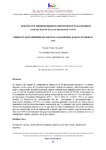Mostrar o rexistro simple do ítem
Influencia de la satisfacción deportiva e interés deportivo en un programa de condición física de fuerza en alumnado de la ESO
| dc.contributor.author | Torres Navarro, Vicente | |
| dc.date.accessioned | 2019-04-30T12:15:23Z | |
| dc.date.available | 2019-04-30T12:15:23Z | |
| dc.date.issued | 2018 | |
| dc.identifier.citation | Sportis, 2018, 4 (1):16-36 ISSN: 2386-8333 | es_ES |
| dc.identifier.issn | 2386-8333 | |
| dc.identifier.uri | http://hdl.handle.net/2183/22799 | |
| dc.description.abstract | [Resumen] El objetivo del estudio es comprobar la influencia de la satisfacción deportiva y el interés deportivo en la mejora de 3 pruebas físicas (salto vertical con impulso, salto horizontal a pies juntos y lanzamiento de balón medicinal, estas dos últimas desde parado) a partir de un pre-test y un pos-test en un grupo experimental (n=81) y un grupo control (n=79) tras un programa de entrenamiento de condición física de fuerza, en función del sexo (M=82; F=78) y del curso (1º de Enseñanza Secundaria Obligatoria -ESO- = 60; 2º ESO=51; 3º ESO= 49) en un centro escolar. La frecuencia del entrenamiento fue de 1 día/semana de aproximadamente 1 hora/sesión. Mediante ANOVA de medidas repetidas aplicando el post-hoc de Tukey hemos respondido a las hipótesis planteadas, concluyendo que los alumnos con menos satisfacción e interés con la práctica deportiva son los que más mejoran el rendimiento. No se ha encontrado que un determinado nivel de satisfacción e interés deportivos mejore significativamente la fuerza (p>0.05) en los alumnos del grupo experimental respecto a otros con distintos niveles de satisfacción e interés deportivo del grupo control. | es_ES |
| dc.description.abstract | [Abstract] The objective of the study is to verify the influence of sports satisfaction and sports interest in the improvement of 3 physical tests (vertical jump with impulse, horizontal jump to feet together and throwing of medical ball, these last two from stopped) from a pre-test and posttest in an experimental group (n=81) and a control group (n=79) after a strength training program, according to sex (M=82, F=78) and of the course (1st Education Obligatory Secondary –ESO- = 60; 2nd ESO=51; 3rd ESO=49) in a school. The training frequency was 1 day/week of approximately 1 hour/session. Through ANOVA of repeated measures applying the post-hoc of Tukey we have responded to the hypotheses raised, concluding that the students with less satisfaction and interest with the sport practice are the ones that improve the performance. It was not found that a certain level of sports satisfaction and interest significantly improved the strength (p>0.05) in the students of the experimental group compared to others with different levels of satisfaction and sports interest of the control group | es_ES |
| dc.language.iso | spa | es_ES |
| dc.publisher | Universidade da Coruña | es_ES |
| dc.rights | Atribución-NoComercial-SinDerivadas 3.0 España | es_ES |
| dc.rights.uri | http://creativecommons.org/licenses/by-nc-nd/3.0/es/ | * |
| dc.subject | Evaluación | es_ES |
| dc.subject | Fuerza | es_ES |
| dc.subject | Interés deportivo | es_ES |
| dc.subject | Práctica deportiva | es_ES |
| dc.subject | Pruebas físicas | es_ES |
| dc.subject | Satisfacción deportiva | es_ES |
| dc.subject | Evaluation | es_ES |
| dc.subject | Force | es_ES |
| dc.subject | Physical tests | es_ES |
| dc.subject | Sports interests | es_ES |
| dc.subject | Sports practice | es_ES |
| dc.subject | Sport satisfaction | es_ES |
| dc.title | Influencia de la satisfacción deportiva e interés deportivo en un programa de condición física de fuerza en alumnado de la ESO | es_ES |
| dc.title.alternative | Influence of sports satisfaction and interest on a physical fitness program of students in ESO | es_ES |
| dc.type | info:eu-repo/semantics/article | es_ES |
| dc.rights.access | info:eu-repo/semantics/openAccess | es_ES |
| UDC.journalTitle | Sportis | es_ES |
| UDC.volume | 4 | es_ES |
| UDC.issue | 1 | es_ES |
| UDC.startPage | 16 | es_ES |
| UDC.endPage | 36 | es_ES |
| dc.identifier.doi | https://doi.org/10.17979/sportis.2018.4.1.2089 |






